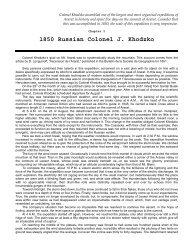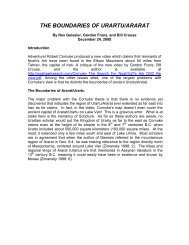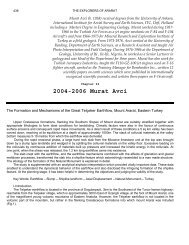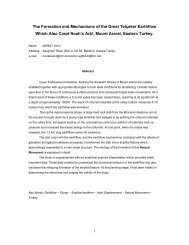1876 British Viscount & Ambassador James Bryce - Noah's Ark Search
1876 British Viscount & Ambassador James Bryce - Noah's Ark Search
1876 British Viscount & Ambassador James Bryce - Noah's Ark Search
Create successful ePaper yourself
Turn your PDF publications into a flip-book with our unique Google optimized e-Paper software.
144 THE EXPLORERS OF ARARAT<br />
steep dome of snow breaking down on the east in a grand black precipice. The top is 16,533 feet above the sea, and<br />
11,000 feet above the little alpine plain or circular hollow in the mountains. All we could obtains by way of concession<br />
was an hour and a half to climb to a little church which stands perched on a height 1400 feet above the glen, and<br />
commands a noble view of Kazbek with his attendant peaks. The building interested us as the first specimen we had<br />
seen of Georgian or Armenian architecture; it was, indeed still is, a much visited place of pilgrimage, and seemed to<br />
date from the twelfth or thirteenth century. After waiting ten minutes, we were rewarded, about 4:30 P.M., by seeing<br />
them disperse under the strong breeze, and his glorious snowy crest came out against the intense blue of a sky whose<br />
clearness seemed to surpass even that of the Alps. We returned to the post-house punctually at the appointed hour,<br />
but were met by reproachful faces. “There are now no horses to be had; in your absence other travelers came up, and<br />
being ready to start, called for all that were in the stable; we could not retain them. There will be none fit for work now<br />
before tomorrow morning.” Although secretly rejoiced to have a few more hours under the shadow of Kazbek, still, as<br />
politeness required, we dissembled our satisfaction, were forgiven, and prepared to spend the night at the uninviting<br />
post-house. We were welcomed by a young man with those soft handsome features which are so common among the<br />
Georgians, who turned out to be the Prince of Kazbek, a Georgian noble, who owns this part of the valley. He was<br />
entertaining two or three government employees sent from Tiflis to examine the glacier of Devdorak, which has several<br />
times formed a debâcle, behind which water accumulated in a lake which, breaking out at last, devastated the Terek<br />
valley. Among them was a young engineer from the Baltic provinces, speaking German, and an accomplished<br />
Armenian official, speaking both German and French, with whom we talked about the Caucasus to our heart’s content,<br />
over endless glasses of lemon tea, while the great mountain glittered before us in the clear cold starlight. The scenery<br />
is more savage than beautiful; but if we had not seen the Dariel defile lower down, we should have thought it<br />
magnificent. Nothing can be more beautiful than the view in descending. To the northeast you look up into a<br />
wilderness of stern red mountains, their hollows filled with snow or ice, their sides strewed with huge loose blocks.<br />
These woods are really splendid, composed almost entirely of deciduous trees, beech, oak, hazel, birch, and such like,<br />
and so close as to look perfectly impenetrable. From here the road is pretty enough, but less interesting, and I relieved<br />
its tedium by a long talk with the ladies, who, it appeared, had done us the honor to take us for poets, because we<br />
seemed to admire the scenery, and I had been gathering plants. As we are both lawyers, and considered by our<br />
friends to be rather plain matter-of-fact people, this unexpected compliment flattered us not a little, and on the strength<br />
of it I indited a sonnet to the younger lady’s cigarette, which was however, like its subject, of so evanescent a nature<br />
that it need not be reproduced here. Anxious to lie down and sleep, on the ground, in a post-house, anywhere, we<br />
heard with pleasure the conventional postmaster declare that no horses could be had before nine o’clock next<br />
morning; it was impossible, not a hoof in his stable, nor in any of the peasants’ either. However, our companions, and<br />
especially the Circassian, who, I fancy, had a law-suit in Tiflis, were unwearied and inexorable. The Circassian<br />
barrister bullied the postmaster with so much vigour that horses were found forthwith, and in two hours more we were<br />
rattling over the stones of the capital of Transcaucasia, and on our first night in Asia were received by the drowsy but<br />
friendly servants of the Hôtel de l’Europe.<br />
Chapter III<br />
What I have got to say of particular parts of the country, such as Tiflis, the capital, and Armenia, is reserved for<br />
later chapters. Transcaucasia is a convenient general name for the countries lying between the Black Sea, the<br />
Caspian, and the Caucasus, which make up the dominions of the Czar in Western Asia, the chief of which are<br />
Georgia, which lies along the upper course of the Kur, south of the Caucasus; Armenia, farther south, on the Araxes,<br />
between Georgia, Persia, and Turkey; Imeritia, west of Georgia; and Mingrelia, west of Imeritia, along the eastern<br />
coast of the Black Sea. However, it is a convenient name, and before speaking of each of these countries by itself,<br />
something may be said of the general physical features of Transcaucasia as a whole. It may be broadly described as<br />
consisting of two mountain regions and two plains. First, all along the north, there are the slopes of the Caucasus,<br />
which on this side (at least in its western half, for towards the east the main chain sinks quite abruptly in to the levels of<br />
Kakhitia) sends off several lateral ranges descending far from the axis, and at last subsiding into a fertile and wellpeopled<br />
hilly country. Secondly, on the south, over against the Caucasus, there is another mountain land, less<br />
elevated, but wider in extent, consisting of the chain which under various local names (some geographers have called<br />
it the Anti-Caucasus) runs from Lazistan at the southeast angle of the Black Sea away to the east and southeast till it<br />
meets the ranges of Persia. Towards the south, this chain ramifies all over Armenia, and here attains its greatest<br />
height in the volcanic summits of Ala Göz, 13,460 feet above the sea, while northward its spurs from a hilly country<br />
stretching to Tiflis. These two mountain masses are connected by a ridge which, branching off from the Caucasus<br />
between Elbruz and Kazbek, the two best known of all the summits of that chain, divides the waters of the Kur from<br />
those of the Rion (Phasis), and is crossed by the great road and railway from Tiflis to the Black Sea near the town of<br />
Suram. It is open, bare, and dry; is, in fact, what the Russians call steppe country, or the Americans prairie, through<br />
nearly its whole extent, and though the soil is fertile, much of it, especially towards the Caspian, is but thinly peopled or









